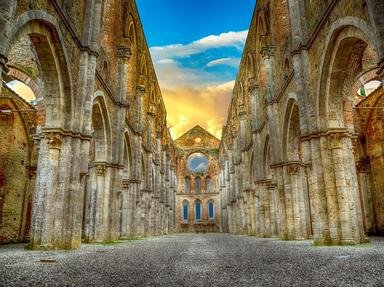Quiz Answer Key and Fun Facts
1. Medieval Marriage: In one of the most significant weddings of the Middle Ages, in 1385 one country's Grand Duke Jogaila converted to Christianity and married the neighboring country's Queen Jadwiga in what is known as the Union of Krewo. Which two states were thus combined in a union that created one of the largest kingdoms in Europe and lasted over 400 years?
2. Medieval Massacre: As the medieval period was disappearing in Western Europe, Hungary's King Louis II and his allies were crushed by an invading power that would eventually reach the walls of Vienna. At Mohacs in 1526 they suffered such a devastating defeat that still today when a catastrophe strikes in Hungary, a Hungarian sometimes shrugs his shoulders and says, "It was worse at Mohacs." Which conqueror, in addition to killing 20,000 Christians in the battle, would afterwards have the heads of another 2,000 prisoners piled at his feet?
3. Medieval Mutilation: The year is 695. The emperor is overthrown and exiled to Cherson in the Crimea. But before being exiled, he suffers the indignity of having his nose cut off by the usurpers. Who was the emperor and what empire did he rule?
4. Medieval Motivator: Urban II is credited with getting the First Crusade started by exhorting French knights to take up the cross in speeches during November of 1095 at the Council of Clermont in Urban's native France. What was Urban's birth name?
5. Medieval Music: Blondel the Minstrel, whose actual name was probably Jean of Nesle (or his son, Jean II of Nesle), is the subject of a medieval legend that his singing of a particular song, known to himself and a formerly crusading monarch, enabled him to discover the king's place of imprisonment and then lead to his freedom. Who is the ruler from the story set in the year 1192?
6. Medieval Mayhem: Basil II was a great Byzantine emperor and sole ruler of the empire from 976 to 1025. Between 986 and 1014 he campaigned against and conquered a neighboring state, ruled by a tsar named Samuel. In the final battle, Basil earned his nickname. He dealt with his 15,000 prisoners by putting them in groups of 100, blinding 99 in each group, and taking only one eye of the hundredth so he could lead the others home. Samuel suffered a stroke when the defeated army got home, dying two days later. Which army was thus treated?
7. Medieval Medicine: In 1403 the 63rd Doge, Michele Steno, imposed one of Europe's first quarantines by setting up the first lazaret, or quarantine station, on the small island of Santa Maria di Nazareth, in an attempt to prevent continued spread of the Black Death from maritime travellers. Which medieval state was ruled by Steno?
8. Medieval Martyrdom: What did the following martyrs have in common? Abraham of Augsburg was burned to death in Augsburg, Germany, in 1265. Katarzyna Weiglowa, or Katherine Weigel, was burned at the stake in Krakow in 1539. Cornelio da Montalcino was burned alive in Rome in 1554.
9. Medieval Motherhood: In 797 when a conspiracy arose against Byzantine Emperor Constantine VI. What did his mother and co-ruler, Empress Irene, do to resolve the power struggle?
10. Medieval Mystery: The Princes in the Tower: Edward IV, King of England, died suddenly in 1483, leaving two sons, ages 12 and 9. The boys were lodged in the Tower of London under the care of their uncle, the Lord Protector Richard, Duke of Gloucester. However, they disappeared and Richard assumed the throne as Richard III that same year. At the time of their disappearance, the older prince would have been Edward V, but who was his younger brother? (If Cadfael had still been around, he would have solved this mystery.)
Source: Author
shvdotr
This quiz was reviewed by FunTrivia editor
bloomsby before going online.
Any errors found in FunTrivia content are routinely corrected through our feedback system.

